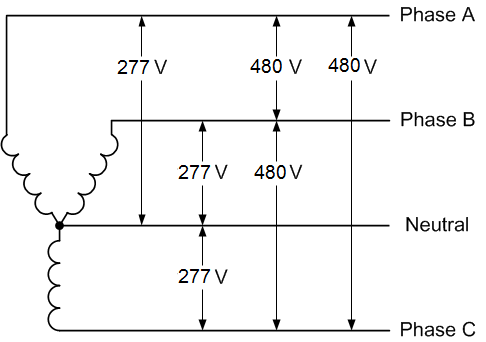Assets

Dell 277V AC & HVDC Power Supplies
Wed, 25 Oct 2023 21:40:08 -0000
|Read Time: 0 minutes
Introduction
This Direct from Development (DfD) tech note describes how mixed-mode 277V AC & HVDC (260-400V DC) power supplies are important, and how they can benefit our customers.
Data center power and high voltages
Although 208V AC is the traditional voltage used in US data centers, there has been a shift towards higher voltages in recent years. Some modern data centers are adopting 415V AC or even 480V AC 3-phase, to further enhance energy efficiency.
480V AC 3-phase is becoming increasingly popular due to its many advantages over traditional 415V AC 3-phase or 240V AC single-phase:
- Less current is needed to deliver the same amount of power as 415V or 240V. Less resistance means less energy loss in cables and electrical components.
- Reduced wiring costs: 480V allows the use of higher gauge, thinner, cheaper wires. This also means reduced installation costs.
- Increased power density: By using 480V, data centers can increase their power density, because more power can be delivered using the same amount of space.
Data centers that are getting 480V 3-phase power from the utility typically convert it to 208V/120V single-phase. To do that, they use transformers. But even with the most efficient transformer, there are power losses during the conversion (around 3%). This is where PSUs that can support voltages higher than 240V AC become relevant.
About 277V AC
To avoid transformer losses and bring single-phase high-voltage directly to the server PSU, a convenient option exists: splitting 480V AC 3-phase into 277V AC single-phase lines.
To do that, data centers typically use Line-to-Neutral Power Distribution Units (PDUs), which divide the 480V AC 3-phase power into three separate 277V AC single-phase lines, by using “Wye” (Y) wiring:

In simple words, 277V AC is derived from 480V AC. If the PSU can directly support 277V AC, there is no need for conversion and no need for a transformer.
That is the first benefit of high-voltage PSUs: they help data centers reduce their energy consumption at the power distribution level.
The advantages of 277V AC
To understand how higher voltage can bring better efficiency, we must look at the basic principle of Power transmission.
Power, measured in watts, is the rate at which energy is transferred. It is proportional to Voltage multiplied by Current:
- Power (Watts) = Electric Tension (Volts) x Current (Amps)
Therefore, if the voltage is increased, the current required to transmit a given amount of power can be reduced. For example, to transmit 10kW of power:
- at 230V AC, the current required is 10kW / 230V = 43.5A
- at 277V AC, the current required is only 10kW / 277V = 36.1A
When transmitting power at 277V AC, the energy loss due to resistance is lower than at 230V AC. Less current (Amps) is needed, resulting in higher efficiency, and potentially significant energy savings.

Less current also means we can use higher gauge (thinner) wires, which use less copper. This can help with space optimization, by either reducing the overall volume of wires or increasing the power density.
So, although 200V-240V AC is the most common voltage range in data centers nowadays, using 277V AC brings considerable advantages:
- Reduced energy losses, resulting in Opex savings
- Reduced equipment expenses and reduced copper
- Reduced space requirements and fewer cable runs in the plenum
- Fewer breakers at the Remote Power Panel (RPP)
- Increased capacity
277V AC business opportunities
Here are the most common business opportunities for 480V AC at the rack and 277V AC at the PSU:
- Large RFPs from the US Federal Government
- HPC customers (optimized power delivery to the cluster and lower energy cost)
- AI/ML customers with high-end GPU-dense platforms
- Any customer looking for more efficiency, energy savings, and carbon footprint reduction
HVDC (260V to 400V DC)
Our high-voltage mixed-mode power supplies support these two input voltages:
- 277V AC
- HVDC (High-Voltage 260-400V DC), this voltage is mostly used by Telecommunications customers.
The advantages of HVDC
High Voltage DC has many advantages over AC and -48V DC in the Telco space:
1. Higher Efficiency:
- vs AC: DC power distribution is usually more efficient than AC power distribution, and higher voltages can improve this efficiency further. Also, fewer conversion stages are needed with HVDC (typically two instead of four).
- vs -48V DC: by increasing the voltage from -48V DC to 400V DC, power losses due to electrical resistance in cables and other components can be reduced, resulting in higher overall efficiency.
2. Lower Cost:
- vs AC: Less Capex with simplified installation and gradual investments compared to traditional AC UPS. Less Opex because easier maintenance leads to lower maintenance costs. HVDC also requires less cooling than AC due to fewer conversions.
- vs -48V DC: Less Capex because 400V DC requires fewer cables (less copper) and smaller/fewer components. Less current is needed compared to -48V DC for the same amount of power, and fewer joules are lost in the distribution.
3. Smaller Footprint:
- Because 400V DC requires fewer cables and electrical components, it can be easier to install. It can also use less physical space within the data center. This can be especially advantageous in high-density environments where space is at a premium.
HVDC business opportunities
Here are the most common business opportunities for HVDC 260-400V DC power:
- Telecom customers who are modernizing their infrastructure, either at the data center level, or at the mobile network level (antennas) where -48V DC is being replaced by 400V DC.
- The adoption of 400V DC power in telecommunications is also driven by standardization efforts. Organizations such as the Telecommunications Industry Association (TIA) and the International Electrotechnical Commission (IEC) have developed standards for higher-voltage DC power distribution in telecommunication applications.
- Renewable energy systems: solar photovoltaic installations, for example, can use 400V DC power.
- Electric Vehicle Charging Stations: EV charging stations can employ 400V DC power for fast charging capabilities. DC charging allows for direct power transfer to the vehicle's battery, reducing charging time and minimizing energy losses.
Conclusion
Modern workloads such as Generative AI or HPC require more and more power, but energy costs are rising at the same time. Therefore, companies all over the world must solve new technical and economic challenges, to power and cool down their infrastructure.
Different solutions are available today to reduce power consumption, such as using more efficient PSUs. For example, 80Plus Titanium PSUs can reach up to 96% efficiency, with only 4% of the electricity lost into heat. This type of PSU can significantly reduce power consumption and cooling costs.
Better efficiency is also achievable by right-sizing the PSU. Overloading and underloading will have a negative impact. A 50% load is considered optimal to get the best efficiency.
For example, when tested at 240V AC, a Dell 1100W Titanium PSU has the following efficiencies:
Dell 1100W Titanium PSU | ||||
PSU load in % | 10% | 20% | 50% | 100% |
PSU load in Watts | 110W | 220W | 550W | 1100W |
PSU efficiency at 240V AC | 90% | 94% | 96% | 91.5% |
But as we look at other ways to maximize power efficiency, we must also consider input voltages and the power distribution itself.
Data centers can achieve massive savings if:
- They can avoid using transformers to convert the high-voltage they get from the power utility, down to the traditional 208-240V AC
- The servers can directly take 277V AC or HVDC with appropriate PSUs
So, as we focus on sustainability, using higher voltages is an impactful way to achieve better power efficiency, reduce energy costs, and reduce the overall carbon footprint.
As data centers continue to grow, in size and number, the impact on the environment increases as well. Therefore, it is important for companies to consider not only the economic implications of their energy usage but also the environmental implications, and work towards more sustainable practices.
Dell is convinced that 277V AC & HVDC voltages can help customers solve some of the complex problems related to power distribution and achieve better sustainability overall.
We are expecting a growing market and infrastructure renewals to support high voltages in the upcoming years. For this reason, our plan is to expand our portfolio of 277V AC & HVDC PSUs and progressively increase the number of compatible platforms.
